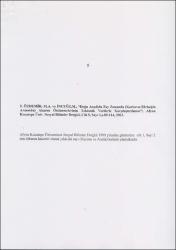Doğu Anadolu fay zonunda (Karlıova-Türkoğlu Arasında) akarsu ötelenmelerinin tektonik verilerle karşılaştırılması
Citation
Özdemir, M.A. ve İnceöz,M., “Doğu Anadolu Fay Zonunda (Karlıova-Türkoğlu Arasında) Akarsu Ötelenmelerinin Tektonik Verilerle Karşılaştırılması”; Afyon Kocatepe Üniv. Sosyal Bilimler Dergisi, Cilt 5, Sayı l,s.89-114, 2003.Abstract
Doğu Anadolu Fay Zonu Türkiye'nin doğusunda Güneydoğu Torosları ve bu dağlar arasındaki çöküntü ovalarını yaklaşık KD-GB doğrultusunda kesen, sol yanal, doğrultu atımlı, aktif bir fay zonudur. Fay sistemi farklı doğrultularda, yer yer kademeli yön değiştiren çok sayıda bölümden (segment) oluşmakta ve genç morfolojisi ile arazide açık olarak izlenmektedir.
Türkiye’nin önemli neotektonik yapılarından biri olan Doğu Anadolu Fay Zonu Alt Pliyosen’de ortaya çıkmıştır. Pliyosen’den önce kurulan büyük akarsular fay tarafından ötelenmiştir. Pliyosen ve geç dönemlerde kurulan akarsular fay zonuna yerleşmiştir. Fayın gençleşmesi akarsu ağında ötelenmelere, keskin dirseklerin oluşumuna neden olmuştur. Drenaj sistemindeki değişikliklerden fayın yanal atımı, fayın gençleşme dönemleri ve faya bağlı jeomorfolojik birimler konusunda bilgiler elde edilmiştir.
Doğu Anadolu Fay Zonu boyunca Karlıova’dan Türkoğlu’na doğru Palu çevresinde Irgat (Caru) Çayı 10 km, Doğanyol ile Hazar Gölü arasında Fırat Nehri 13 km, Gölbaşı ile Erkenek Ovası arasında Fırat Nehri’nin kolu olan Göksu Çayı’na ait Kapı Deresi ve vadisi 14 km, Göksu Çayı ve vadisi 32 km, Aksu Çayı’nın kolları olan Kısık ve Koca dereleri 5 km sol yanal ötelenmiştir. Fay zonu boyunca tespit edilen en büyük akarsu ötelenmesi olan Göksu Çayı vadisindeki 32 km’lik ötelenmenin yörede yapılacak yapısal ve morfolojik araştırmalarla teyit edilmesi gerekir.
Doğu Anadolu Fay Zonu’ndaki akarsularda ortaya çıkan ötelenmeler akarsuların kuruluş dönemlerine bağlı olarak değişmekte ve belirli değerlerde sıkça görülmektedir. Yapı ve morfoloji ilişkisine göre bu değerler 0-250 m’ye kadar Holosen, 250-1500 m ve 4-5 km; Pleyistosen, 5-32 km arasında ise Pliyosen dönemlerine ait olmalıdır. Fırat Nehri ve kolu olan Göksu Çayı ile Ceyhan Nehri’nin kolu olan Aksu Çayı’nın kuruluşu faydan eskidir. Dolayısıyla bu akarsulardaki ötelenme değerleri fayın toplam yanal atımına daha yakın değerler olarak yorumlanabilir.
Akarsu ötelenmelerinin değeri Karlıova'dan Türkoğlu’na doğru artmaktadır. Akarsu ağma göre fayın öncelikle Antakya-Maraş arasında ortaya çıktığı, daha geç zamanlarda segmentler halinde kırılarak Karlıova'ya ulaştığı ileri sürülebilir.
Akarsuların kuruluşu, drenajdaki ötelenmeler, fayın genç morfolojisi, faya bağlı oluşan havzalar, fayın Kuvaterner dönemine ait yer şekillerini kesmesi, deforme etmesi, zon boyunca görülen şiddetli depremler Doğu Anadolu Fay Zonu’nun Alt Pliyosen tektonik hareketleri ile ortaya çıktığını, Pliyosen, Pleyistosen, Holosen ve tarihi dönemlerde zaman zaman gençleştiğini ve fayın aktif olduğunu göstermektedir. The East Anatolian Fault Zone which cuts depression betvveen the Southeast Taurus and these mountains in Eastern Turkey in the direction of NE-SW, approximately is a left lateral, strike-slip, active fault zone. The East Anatolian fault system consists of lots of segments in different directions have step-like change in its directions. In addition, this fault with its young morphology can be clearly seen in the field.
The East Anatolian fault zone, which is one of the important Neo-tectonic structures of Turkey, has appeared in the Lower Pliocene Period. The river drainage which was formed Pre-Pliocene time offset by the fault. The rivers which were formed in the Pliocene and later periods settled to the fault zone. Reactivation of the fault caused offsets in the river drainage and the formation of the sharp tums of the rivers. The strike slip of the fault is obtained from these changes in the drainage system.
Throughout the East Anatolian Fault Zone the following rivers, streams, and valleys have been taken from following left lateral offsets: Irgat (Caru) stream around Palu 10 km; Euphrates betvveen Doğanyol and Hazar lake 13 km; Kapı stream of Göksu river, which is
a tributary of Euphrates, is betvveen Gölbaşı and Erkenek plain 14 km; Göksu river and its valley 32 km; Kısık and Koca streams and their valleys vvhich are the tributaries of Aksu river 5 km. These values of Göksu are the biggest river displacement that have been observed along the fault zone. New researches must be for the straightness in terms of structural and morphological of that value.
Offsets which appear in the rivers of East Anatolian Zone, change depend on the period of their establishment and also are seen in certain values, frequently. According to the relations of structure and morphology, these values in 0-250 m accepted as the Holocene, 250- 1500 m and 4-5 km described as the Pleistocene, betvveen 5-32 km accepted as Pliocene periods. Establishment Euphrates river and its Göksu tributary, Aksu stream, which is a tributary of the Ceyhan river, are older than the fault. So the offset values of these rivers can be said to be closer values to the total lateral.
The value of river offset increases from Karlıova to Antakya. By taking into consideration this can be clearly said that, at the beginning of the fault appears betvveen Antakya and Maraş, and reached Karlıova by being broken as segments in following times.
The formation of the rivers, drainage displacements, young morphology of the fault, basins formed by the fault, the cutting of the Quaternary landforms by the fault and observed destructive earthquakes along the zone show that East Anatolian fault has appeared with lovver Pliocene tectonic movements. Moreover', above mentioned these characteristics indicate that the fault reactivated in Pliocene, Pleistocene, Holocene and historical periods and it is an active fault.
Source
Afyon Kocatepe Üniversitesi Sosyal Bilimler DergisiVolume
5Issue
1Collections
- Cilt 5 : Sayı 1 [19]
- Makaleler [38]



















